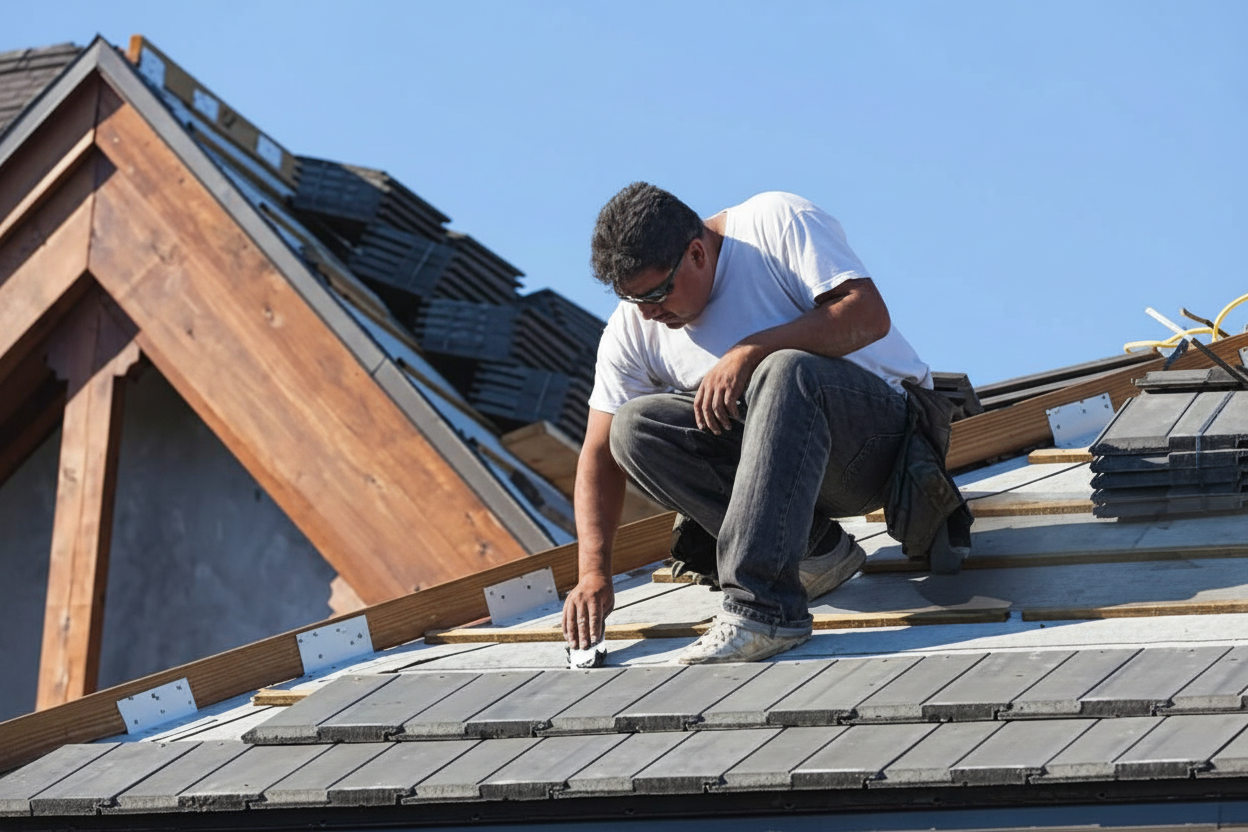How Coastal Air Damages Your Roof in 2025 and How to Stop It
Florida-Specific Roofing & Climate Challenges
November 22,2025
How Coastal Air Damages Your Roof in 2025 and How to Stop It

Alt text: Professional roofer performing thorough inspection on coastal home roof with ocean visible in background
Living near the coast means enjoying ocean breezes and beautiful views, but it also means your roof faces a hidden threat: salt air. If you own a coastal home, you need to understand how salty air silently corrodes roofing materials and what you can do to protect your investment.
Salt-laden coastal air accelerates roof deterioration by up to 40% compared to inland properties, making preventive maintenance essential for waterfront homes.
In this guide, you will learn why salt air is so destructive, how to spot early warning signs, and which materials and maintenance practices work best in coastal environments. We will also show you practical steps to extend your roof’s lifespan and avoid costly emergency repairs.
Why salt air destroys roofing materials faster
Salt air contains sodium chloride particles that cling to roof surfaces and attract moisture from the atmosphere. This creates a corrosive environment that attacks vulnerable components:
- Metal flashings, fasteners, and trim pieces rust rapidly
- Protective coatings break down and lose effectiveness
- Sealants around vents and edges deteriorate
- Underlayment materials weaken and tear
- Traditional shingles become brittle and crack
The closer you live to the ocean, the more concentrated the salt exposure becomes. Homes within three miles of the coast experience the most aggressive corrosion, but even properties further inland can suffer damage during hurricane season when salt spray travels inland.
Without proper protection, metal components can show rust in as little as 18 months. Regular maintenance becomes critical to catch problems before they require expensive repairs.
Warning signs your roof has salt damage
Early detection saves money and prevents water intrusion. Watch for these indicators during your seasonal inspections:
- Rust stains or orange discoloration on metal components
- White salt deposits accumulating on tiles or shingles
- Curling, lifting, or brittle roofing materials
- Cracked or missing sealant around vents and flashings
- Dark streaks or algae growth in shaded areas
Coastal homeowners should inspect their roofs twice yearly, focusing on metal trim, valleys, and any areas where different materials meet.
If you notice any of these signs, take action quickly. What starts as surface corrosion can penetrate deeper layers and compromise your roof’s waterproof barrier. Learn more about identifying storm damage early to protect your home.
Best materials and coatings for coastal protection
Choosing salt-resistant materials makes a significant difference in roof longevity. Here are your best options:
Metal roofing systems
Aluminum and coated steel resist corrosion better than traditional materials. Look for products with multi-layer protective finishes designed for marine environments. Standing seam metal roofs perform exceptionally well because they have fewer exposed fasteners where salt can accumulate.
For coastal installations, consider cool roof options that reflect heat while resisting salt corrosion.
Tile and synthetic alternatives
Clay and concrete tiles naturally resist salt damage, making them popular in coastal regions. Their dense composition prevents salt penetration, and they require minimal maintenance compared to other materials.
When selecting roofing materials for Florida homes, prioritize products tested in marine environments.

Alt text: Homeowner meeting with roofing contractor to discuss protective solutions for coastal property roof
Protective coatings
Applying specialized coatings creates an extra barrier against salt intrusion. Elastomeric and acrylic coatings seal micro-cracks and provide UV protection. Reapply coatings every 3 to 5 years for maximum effectiveness.
| Material Type | Salt Resistance | Typical Lifespan | Maintenance Level |
|---|---|---|---|
| Aluminum Metal | Excellent | 40-50 years | Low |
| Coated Steel | Very Good | 30-40 years | Moderate |
| Clay/Concrete Tile | Excellent | 50+ years | Low |
| Asphalt Shingles | Fair | 15-20 years | High |
Maintenance strategies that actually work
Proactive maintenance prevents small issues from becoming major problems. Follow these proven strategies:
Schedule professional inspections
Have a qualified roofer examine your roof every six months. They can spot corrosion, seal failures, and structural issues before they cause leaks. Regular roof inspections save thousands in repair costs.
Clean salt buildup regularly
Rinse your roof with fresh water twice per year to remove accumulated salt deposits. Use low-pressure methods to avoid damaging roofing materials. Pay special attention to valleys, edges, and areas around vents.
Professional roof cleaning removes embedded salt deposits that regular rain cannot wash away, extending your roof’s lifespan by years.
Replace corroded components promptly
Don’t wait for small rust spots to spread. Replace affected flashings, fasteners, and trim pieces as soon as you notice corrosion. Using stainless steel or coated hardware prevents future problems.
Improve ventilation and drainage
Proper airflow prevents moisture accumulation that accelerates corrosion. Ensure soffit vents, ridge vents, and attic fans work correctly. Clear gutters and downspouts regularly to prevent water backup.
Apply protective treatments
Recoat metal surfaces and reseal vulnerable joints on schedule. This preventive approach costs far less than emergency repairs after leaks develop.
For homes in high-wind coastal areas, learn about securing roof edges from wind damage to prevent uplift during storms.
Understanding Florida’s specific climate challenges helps you time maintenance activities for maximum benefit. Coastal properties also need protection against high humidity damage that compounds salt-related problems.
At Foxhaven, we specialize in protecting coastal homes from salt air damage. Our team understands the unique challenges waterfront properties face and provides tailored solutions that extend roof life while reducing maintenance costs. Whether you need a thorough inspection, protective coatings, or a complete roof upgrade with corrosion-resistant materials, we deliver results that last.
Contact Foxhaven today to schedule your coastal roof evaluation and discover how proper protection saves you money while keeping your home safe and dry for decades to come.
